
By Ferry through the Greek Islands
Greek Ferries
The best way to travel around the Greek islands is, of course, by ferry. They're cheap, fast, and they depart frequently. The traditional ferries, large ones with open decks and great views, are quite cheap. For example, just €6.90 for the eighty minute trip from Ios to Santorini, or €31 for the eight to nine hour trip from Santorini to Athens' port of Piraeus.
The high-speed ferries cost significantly more for the distance covered, but they are still reasonable. For example, €22 to go from Mykonos to Paros and €29 from Paros to Ios, in just 40 and 55 minutes, respectively.
Popular inter-island connections have frequent departures. But some out of the way islands have infrequent ferry service even in high season, and many inter-island connections of possible interest to tourists just don't exist as a one-ferry hop. Santorini-Patmos, anyone? There is no such ferry — you have to make connections on two or three ferries to go between those islands. That's fine, stop off along the way and see some other islands!
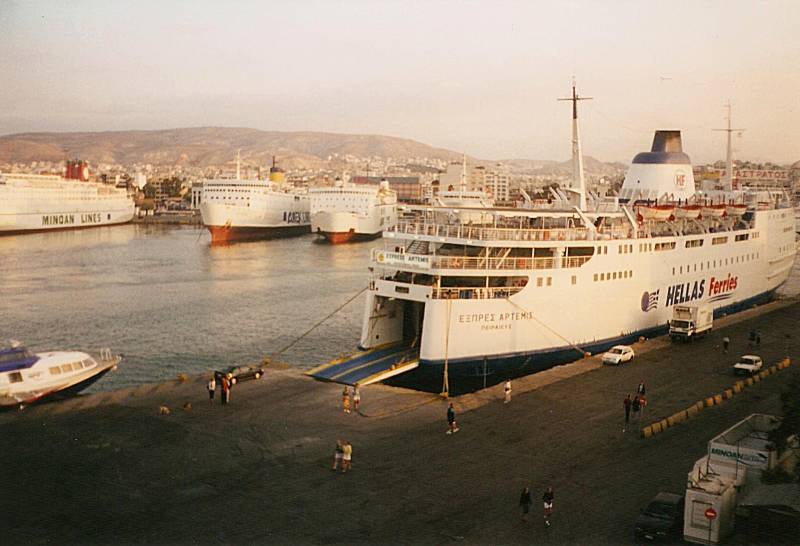
Ferries leaving Athens' Piraeus port for the islands early in the morning.
Start planning your trip! The below search engine let you look up ferry schedules, and you can purchase your tickets on line.
Check ferry schedules and buy tickets:
Ferries from Athens to the Islands
Travel in mainland Greece can be frustrating. The trains can be slow. The Athens bus stations are something out of the third world. And yes, there are two Athens bus stations with service to different regions, with very limited public transport to them and even less between them.
Compared to the mess of mainland travel, the Greek ferries are great!.
Athens is the main ferry hub. Well, really Piraeus, the nearby port for Athens. The subway system can get you to Piraeus where you can board your ferry to the islands.
Ferry lines run like a complicated star out of Piraeus: north-east to Chios, Lesvos, and Limnos; straight east to Samos; and southeast through the Cyclades toward Crete and Rhodes.
Dodecanese ferries run between Rhodes and Samos with stops all along the way.
In the middle of the Cyclades, Naxos and Paros are other major hubs connecting the Athens-Cyclades lines with those running to the Dodecanese islands close to the Turkish coast. So, for that theorized Santorini-Patmos trip, you would probably go via Naxos or Paros, or possibly Mykonos.
Do remember that the Greek islands are, well, Greek, and therefore they have Greek names. You will probably see them listed in the Latin alphabet at the ticket office, but be aware that the process of transliterating Greek into the Latin alphabet (very loosely, "spelling Greek in English") is not done consistently. You might see "Thira" in one place and "Thera" in another. And the Greeks tend to be more accurate about transliterating Greek as opposed to adopting Italian names from the Middle Ages, as we English-speakers do. They use Rodos instead of Rhodes and Creta or Kreta instead of Crete.
| English | Greek |
| Crete (Kriti) | Κρητη |
| Ios | Ιος |
| Kos | Κος |
| Mykonos | Μυκονος |
| Naxos | Ναξος |
| Paros | Παρος |
| English | Greek |
| Patmos | Πατμος |
| Piraeus (Athens) | Πηραευς |
| Rhodes (Rodos) | Ροδος |
| Samos | Σαμος |
| Santorini Thira |
Σαντορινη
Θηρα |
That brings up the important point that one of the most popular islands to visit is known to the west by the Italian name given to it by its Italian occupiers of the Middle Ages — Santorini — while the actual name of the island is Θηρα or either Thira or Thera. Also, ferries don't go to Athens, which is several miles inland, they go to its port of Piraeus.
Plus there are the challenges posed by ticket sellers' handwriting, whiteboards that haven't been updated yet so that "Today" and "Tomorrow" really refer to "Yesterday" and "Today", and so on. It's all part of the adventure!
The port of Piraeus is a beehive of activity every day in the early morning. A fleet of ferries departs Athens between about 0700 and 0830.
You'll need to get to the port in plenty of time. It will take you a while to get from the Metro station to your ferry. You will spend a significant part of that time figuring out where you need to go. There will be huge crowds of people hurrying to their ferry. And, this is the one place where there seems to be some form of regulation and ID checking. Once you get out of Piraeus, ferry travel becomes much more casual.
Ferry stops on the islands are models of efficiency. A ferry will pull into the harbor, spin around while dropping its rear ramp onto the pier, unload two trucks and a car, let out a mob of passengers and take on an outbound mob, and load up a couple of cars. Then they crank up the engines and pull out as the ramp is being raised. Total time from when the ramp first touches concrete to when it lifts off: maybe six and a half minutes. This efficiency is in stark contrast to most things in Greece — the mainland and the islands are like two separate countries.
Inter-Island Ferries: Mykonos to Paros
Time gets close as the ferry approaches the harbor entrance. Everyone starts walking out to where the ferry will dock. This is on Mykonos, and we are going to Paros. The ferry dock on Mykonos is a short walk of maybe 200 meters north from the central square of Hora. On most islands, the main town is called Hora or Χορα. That means, roughly, "Town".

Everyone heads out to the pier as the SeaJets ferry approaches Mykonos.
I had purchased the tickets the afternoon before at one of the ticket offices in Hora. You don't have to buy your tickets way in advance, but then you don't want to wait until the last moment because the ferry will only be in port for just a few minutes. Once you see it coming, it's far too late to buy a ticket!

The SeaJets ferry approaches the pier on Mykonos.
Here it comes! This is one of the SeaJets catamarans. These use two fairly small gangplanks to board passengers through door-sized hatchways. This makes their stops relatively longer, but even so, they are tied up for no more than maybe fifteen minutes.

SeaJets fast catamaran at the pier in Mykonos.
Paros to Ios
Let's take another inter-island hop. We're on Paros, wanting to go to Ios.
Notice that this office lists the ferries in two colors, blue for normal and red for high speed. Some islands are reachable from here only by one type or the other. You can also see from this board that only some of the routes operate every day.
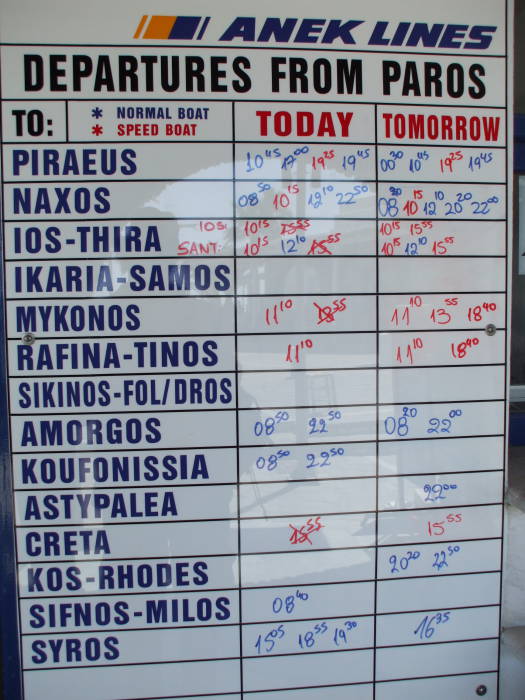
Typical Greek ferry schedule board in the ferry ticket office on Paros.
There's the one we want, leaving at 1555. They haven't updated the board yet. It's about 11 AM but the board still shows the schedule from yesterday. Today's ferries are listed under "Tomorrow". A high-speed ferry comes through here at 1555, going to Ios and then continuing to Thira and on to Crete. It might appear that several ferries leave simultaneously, but that's one ship stopping on a series of islands.
Here are handy Greek words to use while pointing to the schedule board with a puzzled look:
| Σήμερα? | Símera? | Today? |
| Αύριο? | Aírio? | Tomorrow? |

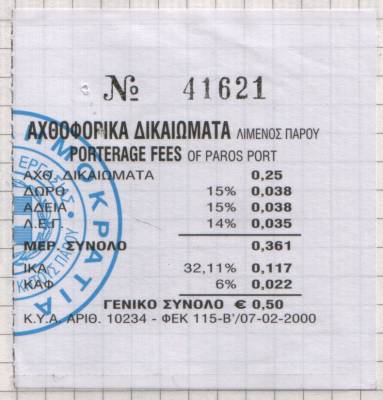
We'll get our ticket now. It's €29 for the ticket itself plus €0.50 for the "porterage fees", basically a port tax. This ferry ticket is relatively expensive because it's for a Flying Cat, one of the fastest and very large ferries.
A Hellenic Seaways Flying Cat approaches the Paros pier. This one is not ours, it is scheduled for a departure just about 10 minutes ahead of our ferry. These move fast enough that our ferry is following just ten minutes behind but it is not yet in sight.

Hellenic Seaways line Flying Cat approaches the pier on Paros.
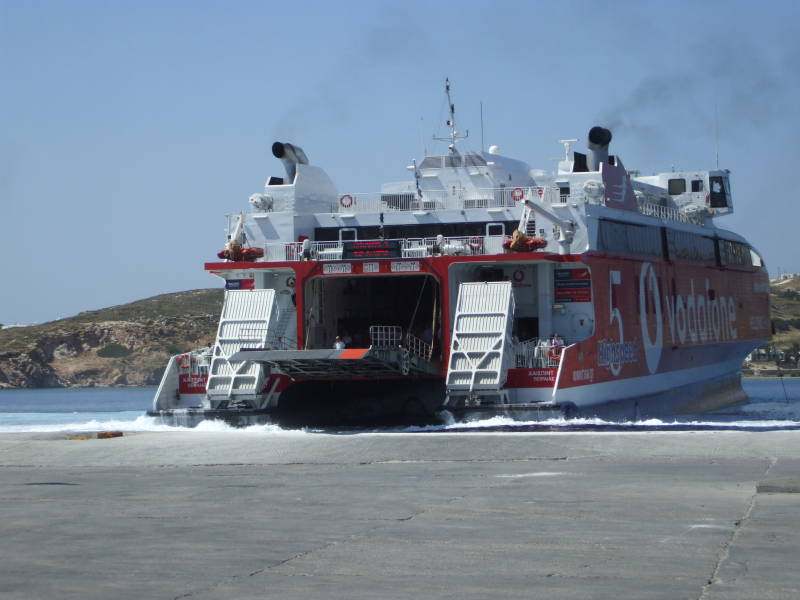
The ramp starts down as it approaches the pier.
The ramp is coming down as the ferry turns into alignment with the pier and backs in. These have thrusters fore and aft, and they are highly maneuverable.

The ramp is about to touch down as the lines are thrown ashore.
Crew on board the ferry throw lines to two men on the pier. They loop those lines around large bollards. The ferry winches itself in against the pier as the engines try to push the ferry away, keeping tension on the lines.

Disembarking passengers stream out of the ferry.
The ramp has touched down and the disembarking passengers are coming out. A few vehicles may be driven on and off, and the outbound passengers for this ferry will walk up the ramp.
However, they only lowered the main ramp and so this is probably a passenger-only stop. If they were unloading and loading both passengers and vehicles, then would have lowered at least one of the smaller passenger ramps (bright white, to either side) and moved both vehicles and people simultaneously.
Meanwhile, the next ferry, ours, has rounded the point and is rapidly approaching the port. We will follow the same procedure, and both these ferries will be gone in just a few more minutes.

Here comes the next ferry!
We have just found our seats, and we are already well on our way out of Paros port! The Flying Cat ferries move at high speed, there is no exterior deck. The seats are about like those on airliners.
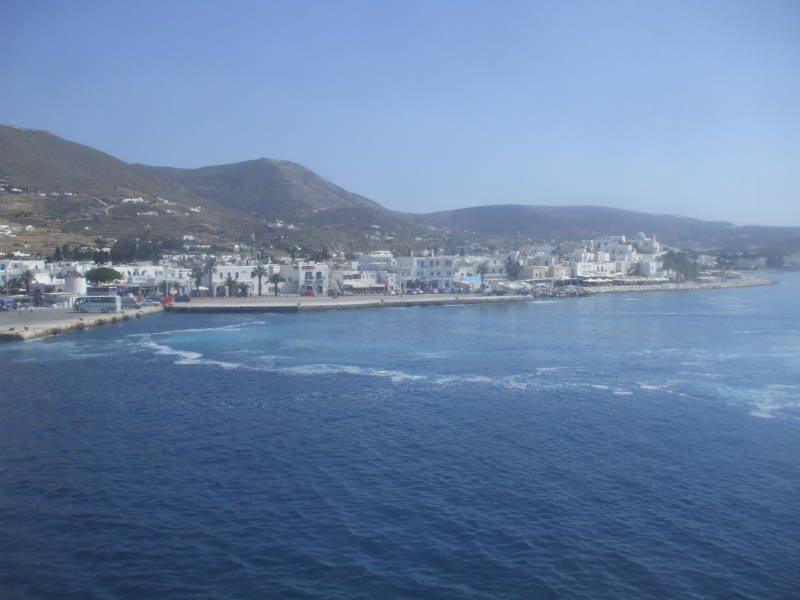
Looking back to the Paros port from the departing ferry.
In just about 50 minutes we are approaching Ios harbor. It's time to get down to the vehicle deck to be ready to disembark.

View out the stern as we approach Ios harbor.
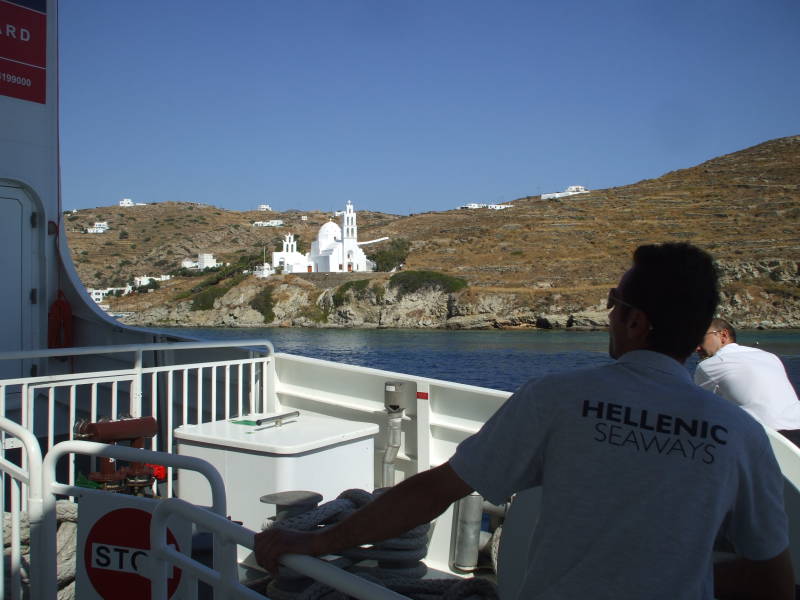
White chapels appear as we come into Ios harbor.
We're coming into Ios harbor. Small white chapels lie well outside the port town. The Hora here is in a saddle well above the port.
Everyone disembarking at Ios comes down to the vehicle deck. We carried our bags on board and most were left down here. There happen to be no vehicles on board for this leg.

Luggage and a few passengers in an otherwise empty vehicle deck.
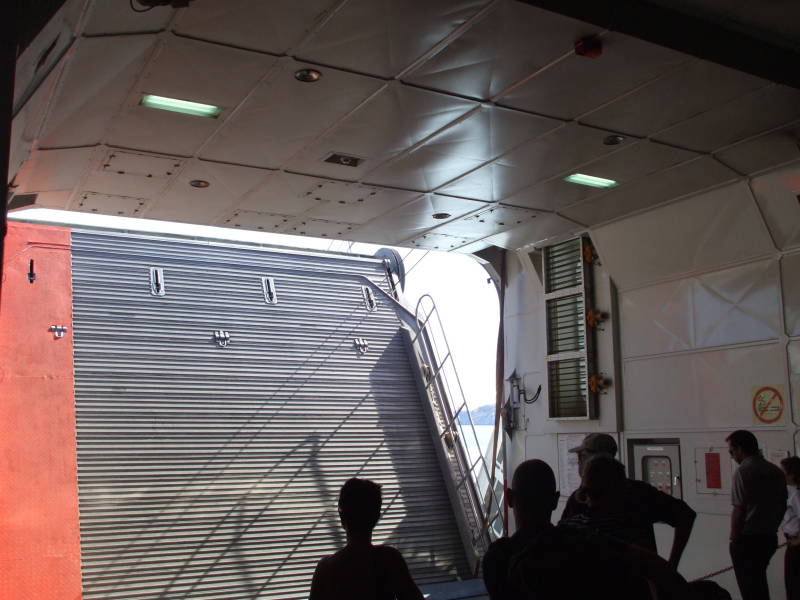
The ramp starts down.
A klaxon sounds and yellow rotating beacons start spinning overhead on the vehicle deck as the ramp starts down.
The ramp continues to lower further as the ferry maneuvers into place. As soon as it touches down, everyone will hurry down the ramp.

The ramp lowers further.
By the time you're out through the gate and off the pier, the ferry is on its way out of the harbor toward its next destination.
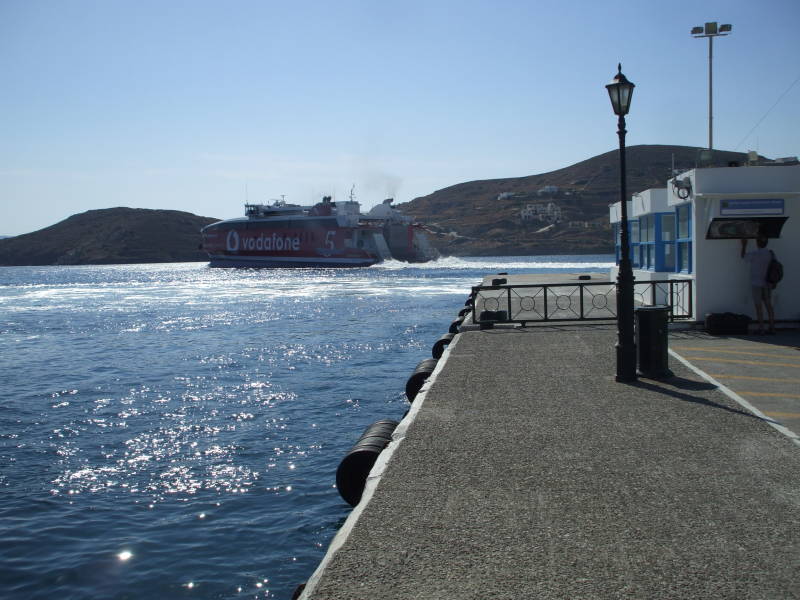
And there it goes, on to Thira.
Ferries like this typically take less then seven minutes from when the ramp first touches the pier until they are raising the ramp and pulling out.
Ios to Santorini
The next hop is from Ios to Santorini. You want to make this trip on an older, slow ferry, one with an open deck where you can go out and watch as you pull into the large caldera.
And while you'll be thinking about Santorini, remember that the Greek name is Θηρα or Thira. It may be listed either way, see "Santorini" on this schedule but "Thira" on the ticket below.

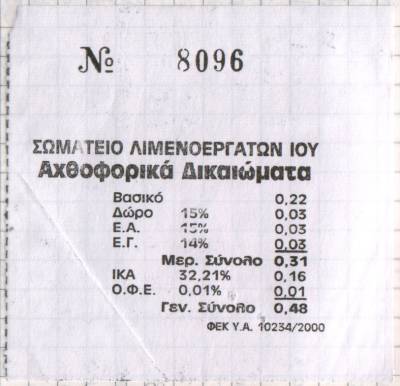
This ticket is much cheaper, just €6.90 for the trip from Ios to Thira on board the F/B Artemis. Plus a meticulously calculated €0.48 in port tax. The trip will take just about 80 minutes.
The Greeks insist on looking at a passport so they can put a name on the ticket. But they only copy your family name. For a first initial, you get some random letter. I was "M Cromwell" on this one, "J Cromwell" on the one above. This is so that if a ferry goes down, they have at least a count of how many were on board and a very approximate list of who they were.

Updating the ferry schedule.
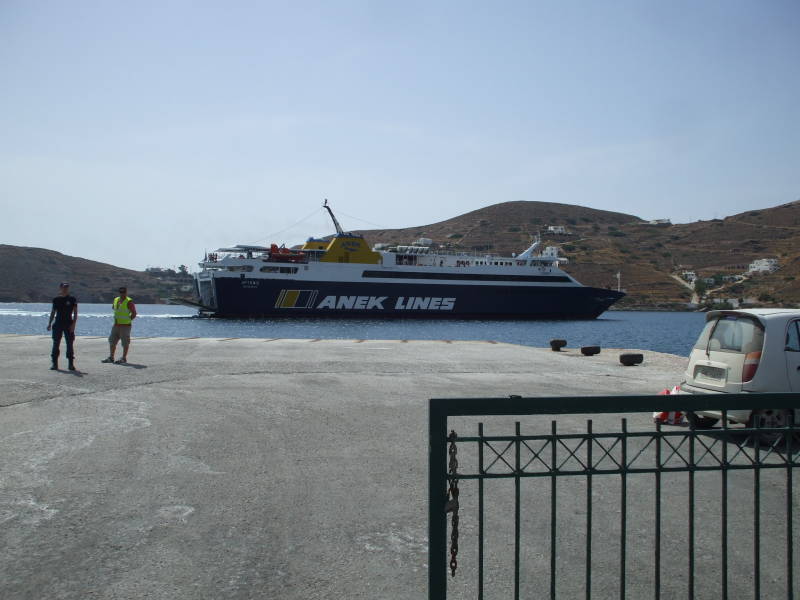
The F/B Artemis enters the harbor.
The F/B Artemis is one of the more traditional ferries. It has several decks, two of them open for great views.
It's pulling into Ios harbor here. It isn't as rapidly maneuverable as the Flying Cat, but it still makes port calls pretty quickly.
Everyone hurries on board. This ferry may not move nearly as fast as the Flying Cats at sea, but its port calls are still very short.

Passengers board the F/B Artemis.
The traditional destination board above the main ramp lists the ports of call. The Artemis would have left Piraeus about 0800, and it's 1550 now on Ios. It has made just one stop along the way so far, on Naxos. We will be on Thira in about 80 minutes. From there it will continue to Sikonos, Folegandros, Kimolos, and Milos, smaller islands with less frequent ferry service. In keeping with tradition, the clock doesn't do anything.
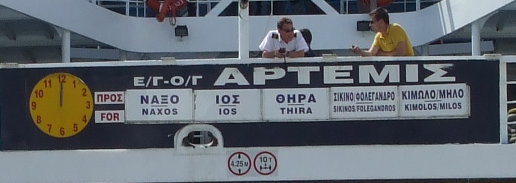
Santorini is visible on the horizon as soon as we get around the southwestern point of Ios.
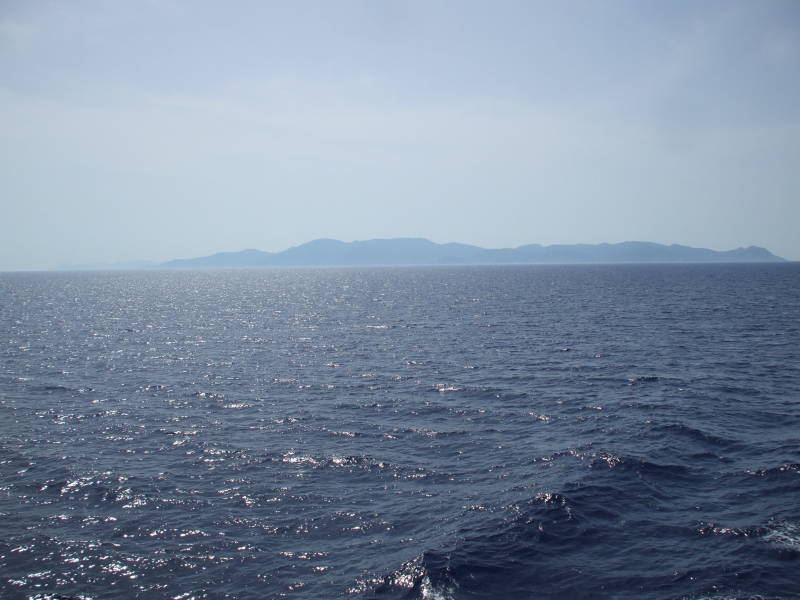
Santorini is soon visible.

Structures become visible on Santorini.

Map of Thira. The main town is Fira, spelled Thira on this map. The new ferry port is at Pirgos.
We start to see settlements as we approach. And, we are starting to see that we will be going into the large caldera between the main "C" shaped island and the smaller islands making up the remnants of the once round island.
At left in the first picture below you see Oia. It's the second largest town on Santorini, at the northern tip of the main island. Beyond it, perched along the cliffs above the central caldera, is the largest town of Fira, previously spelled Thira. It was pronounced "Fira", so the spelling was eventually changed to reflect use.
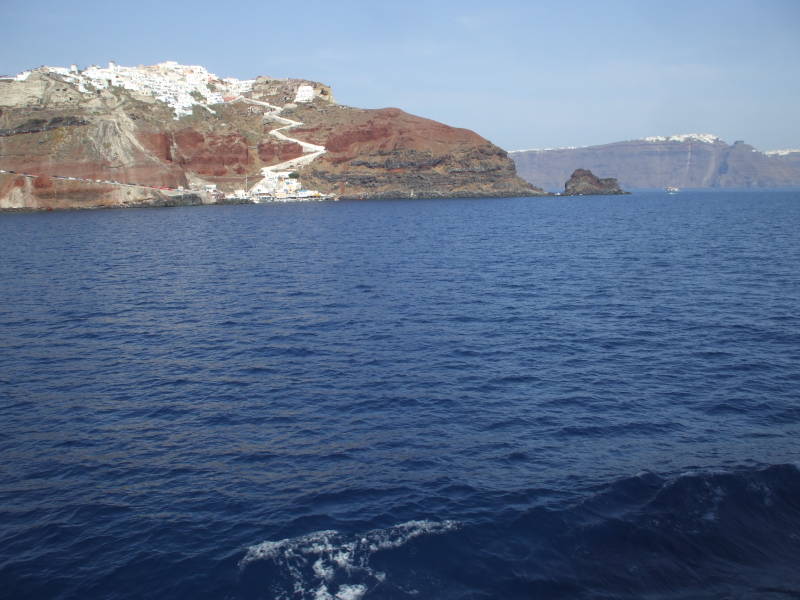
Oia at the northern tip, with Fira visible in the distance.
Here is a better view of Oia. It was the main settlement on Thira until a big earthquake in the 1950s. The rebuilding after the earthquake coupled with the huge increase in tourism led to Fira becoming the main town.

The town of Oia.
Oia had been the main town until maybe the early 1970s. It had the main port. A new port was built at Pirgos, with a steep switchback road leading up to the caldera rim. Cruise ships stay out within the caldera, and small boats take their passengers to and from a small pier below Fira. From there, take a cable car, or walk or ride donkeys up a steep switchback path to Fira.
Fira is built along the cliffs extending up to 300 meters above the waterline and continuing at least that far below. You can see the multi-colored layers of volcanic material laid down through millennia of eruptions, until the big explosion that largely destroyed the once circular and conical island around 1600 BC.

Fira, atop the 300 meter cliffs.
The island was about 15 to 20 kilometers in diameter, a conical volcano. The explosion that largely destroyed it is now estimated to have expelled about 100 cubic kilometers of magma and rock. See the page about Santorini for details on its history and geography.
Ferry Routes and Times
Ferry schedules change throughout the year. Let's use Piraeus (Athens) to Patmos as an example. There might be two ferries connecting those ports each day during the high season of July and August. During the shoulder season from the middle of April through June, and again in September and October, that route might have one ferry a day. And then during the low season of November until early to mid April, it might be a few days between ferries.
The easiest way to plan would be to check schedules with the below search engine. You can see how often a ferry makes that run, and how long it takes. You can even buy your tickets on line.
Check ferry schedules and buy tickets:
Watch out for strikes!
Keep in mind that communism is thriving in Greece and ferry strikes are common. (along with rail strikes, bus strikes, subway strikes, ...) If you aren't inconvenienced by a strike, you will see the posters and the red hammer and sickle graffiti painted all over Athens. Ferry schedules more than a day in advance may be no more than suggestions.


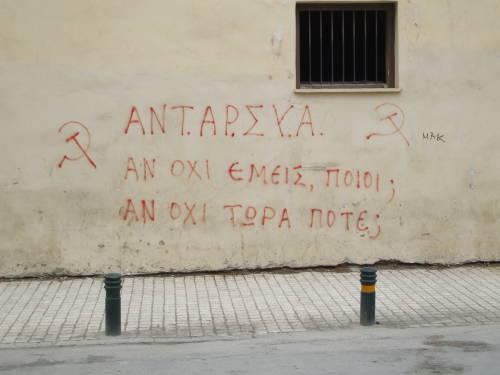
Greek Ferry Search and Ticketing:
Start with these general search sites.
However, beware that I was told by the Greek national
tourism office in New York that all these sites are
pretty useless during the winter.
go-ferry.com
openseas.gr
danae.gr
ferries.gr
For further details, see individual ferry companies.
Anek Lines
Hellenic Seaways
Minoan Lines
Seajets
Superfast Ferries
Dodekanisos Seaways
Blue Star Ferries
Ferries Between Greece and Turkey
Travel inTurkey
The animosity between Greece and Turkey requires you to set up this trip a day in advance, as each side blames the other for laborious paperwork. Ferries run daily between the main harbor on Rhodes and Marmaris, Turkey.
The hydrofoil ferry we see here is one of the Soviet surplus ones. Their design embodies what people in the past thought the future was going to look like.
Travel inEstonia
These are Восход (Voskhod, meaning "Sunrise") passenger hydrofoils, also called Design 352 and Design 03521. They can carry 71 passengers, cruise at 60 kilometers per hour, and they have a range of 500 kilometers. They were built at the Море or Morye shipyard in Crimea, Ukraine. I've also ridden these, or a model very similar, between Helsinki, Finland and Tallinn, Estonia.
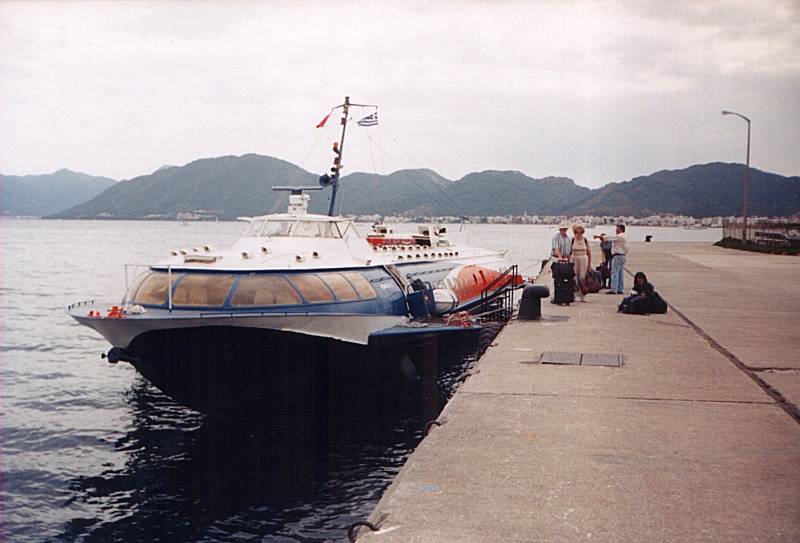
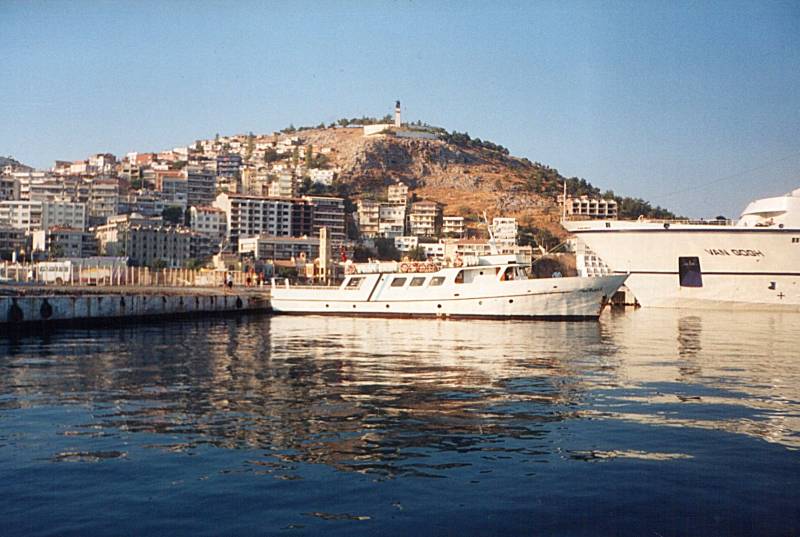
This small ferry is preparing to leave Kusadaşı and cross to Samos.
If you are traveling between the Greek islands and Turkey, you are likely to pass through Samos.
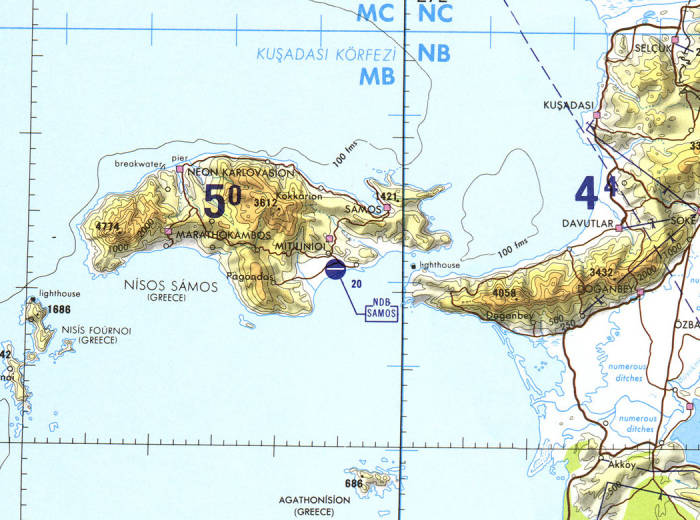
A small ferry links Samos with the Turkish port of Kusadaşı every day during the high seaon. It is a short dolmuş ride from Kusadaşı to Selçuk and the ancient city of Ephesus.
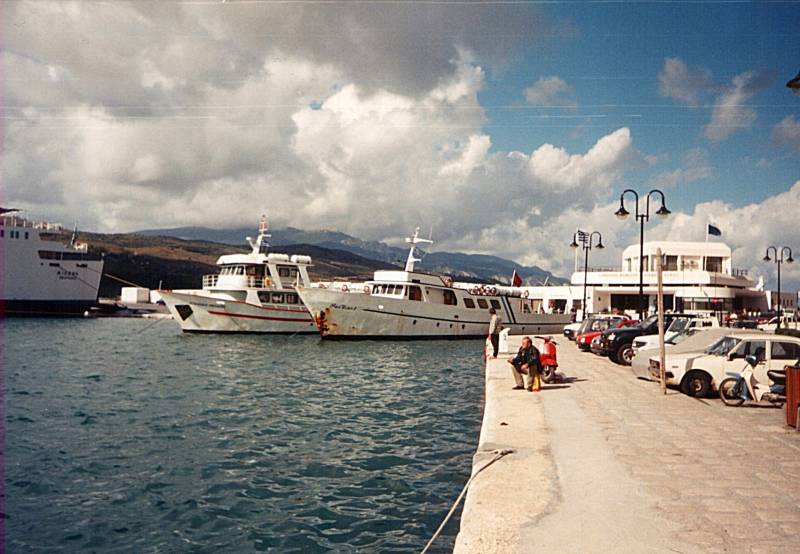
This small ferry from Kusadaşı has arrived at Samos.
Some times of the year there is a single ferry each day, going from Turkey to Greece early in the morning and returning to Turkey in the late afternoon. Other times there is one each direction in both morning and afternoon. Service drops to maybe twice a week during the winter months.
